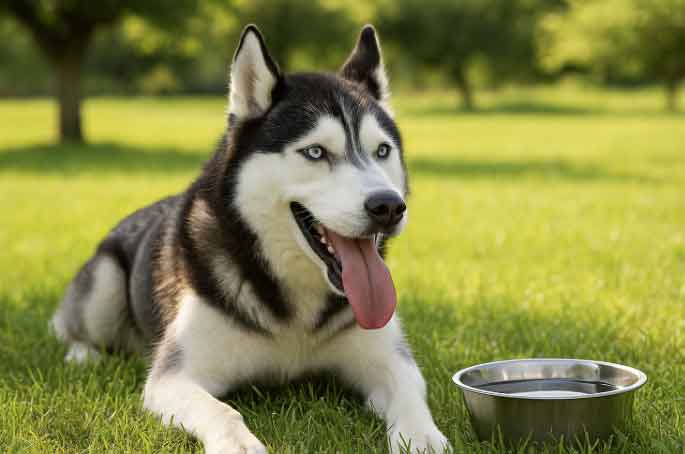Can a Dog Get Heat Exhaustion? Signs, Prevention & First Aid
As temperatures rise, pet owners must ask: can a dog get heat exhaustion? The short answer is yes. Just like humans, dogs are susceptible to overheating, which can quickly become dangerous—even fatal—if not addressed. In this guide, we’ll cover everything you need to know about recognizing, preventing, and treating heat exhaustion in dogs.
Table of Contents
- What Is Heat Exhaustion in Dogs?
- Signs and Symptoms of Canine Heat Exhaustion
- Common Causes of Heat Exhaustion
- Which Dogs Are Most at Risk?
- First Aid: What to Do If Your Dog Overheats
- How to Prevent Heat Exhaustion in Dogs
- FAQ
- Conclusion
What Is Heat Exhaustion in Dogs?
Heat exhaustion occurs when a dog’s body temperature rises above normal (over 103°F or 39.4°C) due to environmental heat or physical activity. If untreated, this can progress to heatstroke, which can damage organs and be life-threatening. Dogs don’t sweat like humans—they rely mainly on panting and paw pad sweat glands to regulate temperature, making them more prone to overheating.
Signs and Symptoms of Canine Heat Exhaustion
Recognizing the early symptoms is crucial. Look out for the following signs:
- Excessive panting or drooling
- Rapid heartbeat
- Weakness or lethargy
- Vomiting or diarrhea
- Bright red or pale gums
- Confusion or stumbling
- Collapse or seizures (in severe cases)
Early detection can make a huge difference in your dog’s recovery.

Common Causes of Heat Exhaustion
Dogs can overheat for many reasons. The most common include:
- Hot weather: Especially when paired with high humidity
- Excessive exercise: Running or playing in hot temperatures
- Lack of shade and water: Dehydration accelerates overheating
- Confinement in hot areas: Cars, poorly ventilated rooms, or kennels
Which Dogs Are Most at Risk?
All dogs are at risk, but some are more vulnerable:
- Brachycephalic breeds: Bulldogs, Pugs, Boxers, and Shih Tzus (short-snouted dogs struggle with airflow)
- Overweight dogs: Excess body fat insulates heat
- Puppies and seniors: Poorer heat regulation ability
- Thick-coated breeds: Huskies, Malamutes, and Golden Retrievers
First Aid: What to Do If Your Dog Overheats
If you notice signs of heat exhaustion, act fast:
- Move to a cooler area: Indoors with air-conditioning or into the shade
- Offer water: Let your dog drink in small sips (not too much at once)
- Cool the body: Wet towels, fans, or cool—not ice-cold—water on paws, armpits, and groin
- Monitor temperature: Use a rectal thermometer if possible. Ideal body temperature is 101–102.5°F
- Call your vet immediately: Even if symptoms improve, medical attention is advised
How to Prevent Heat Exhaustion in Dogs
Prevention is always better than treatment. Here’s how to keep your dog cool and safe:
- Walk during cooler hours: Early morning or late evening
- Never leave dogs in cars: Even with windows cracked, cars heat rapidly
- Provide shade and fresh water: Indoors and outdoors
- Use cooling products: Mats, vests, or dog-safe frozen treats
- Limit intense exercise: Especially for brachycephalic breeds
FAQ
Can dogs really die from heat exhaustion?
Yes. If left untreated, heat exhaustion can escalate to heatstroke, causing organ failure or death within minutes.
How can I cool my dog quickly?
Move them to a shaded or cool area, offer water, and apply damp towels to the neck, groin, and paws. Avoid using ice-cold water which may constrict blood vessels.
Are fans enough to cool my dog?
Fans can help, but they are not as effective for dogs as for humans since dogs don’t sweat. Combine with water and shade for best results.
Can I give my dog ice cubes?
Yes—in moderation. Ice cubes or frozen broth can be a great cooling treat, but don’t give too many too fast to avoid digestive upset.
Should I shave my dog to keep them cool?
Not always. Some breeds rely on their coat for insulation. Shaving may expose them to sunburn. Consult your vet before trimming.
Conclusion
So, can a dog get heat exhaustion? Absolutely. And the consequences can be dire. The good news is that with awareness, proper care, and timely intervention, heat exhaustion is completely preventable. Always prioritize hydration, shade, and rest for your pup—especially in hot weather. Your dog relies on you to keep them cool, comfortable, and safe all year round.

